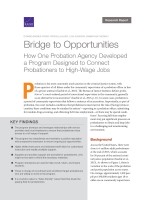| 来源类型 | Research Reports
|
| 规范类型 | 报告
|
| DOI | https://doi.org/10.7249/RR2179
|
| 来源ID | RR-2179-RC
|
| Bridge to Opportunities: How One Probation Agency Developed a Program Designed to Connect Probationers to High-Wage Jobs |
| Dionne Barnes-Proby; Priscillia Hunt; Lisa Jonsson; Samantha Cherney
|
| 发表日期 | 2018
|
| 出版年 | 2018
|
| 页码 | 20
|
| 语种 | 英语
|
| 结论 |
Seven facilitators were identified that aid program development and continued operation.- The program develops and leverages relationships with service providers and local employers to ensure that probationers have access to a full range of support.
- The program has established and maintains a positive reputation with prospective employers to ensure ongoing job opportunities.
- Highly skilled instructors and dedicated staff allow for customized instruction and readily available support.
- Supplies and ancillary support are provided for probationers, who might not be able to afford the necessary materials.
- Program champions are used to help recruit, retain, and inspire students.
- Those in charge of recruitment and enrollment target probationers who are willing to invest in the program.
- It is crucial to select a "felon-friendly" career field that levels the playing field for probationers.
A few program barriers were also identified.- Some probationers are unable to commit up to nine months to an unpaid program.
- Juggling competing demands might impact program participation and subsequent job retention.
- Limited transportation options make it difficult for probationers to attend classes.
- Issues with driver's licenses limit job opportunities for probationers.
- Substance use drives down recruitment and retention rates.
|
| 摘要 |
- Explore funding opportunities to support a subsidy or stipend for program participation. This work incentive model has proven to be effective at improving retention.
- Improve coordination between the probation officers and program staff to minimize student absenteeism. Develop a retention program that includes follow-up with probationers during the program and after job placement. Identify and address reasons for discontinued participation.
- Increase shuttle pick-up locations to include some remote options. Offer additional alternative modes of transportation (e.g., taxi service). Supportive services like transportation are critical to program engagement and completion.
- Identify funding sources and support services to assist probationers with addressing their driver's license issues. This may include collaborating with the Department of Motor Vehicles to identify a way to address the needs of probationers while still attending to the reason for the suspension or revocation in the first place.
- Consider partnering with a drug treatment program to provide onsite services to prospective and current program participants to address issues with substance use. While these services are available in the community, having an onsite provider might encourage participation by eliminating the logistical barrier.
|
| 主题 | California
; Employment and Unemployment
; Labor Markets
; Parole
; Probation
; Recidivism
; Vocational Education
|
| URL | https://www.rand.org/pubs/research_reports/RR2179.html
|
| 来源智库 | RAND Corporation (United States)
|
| 引用统计 |
|
| 资源类型 | 智库出版物
|
| 条目标识符 | http://119.78.100.153/handle/2XGU8XDN/108776
|
推荐引用方式
GB/T 7714 |
Dionne Barnes-Proby,Priscillia Hunt,Lisa Jonsson,et al. Bridge to Opportunities: How One Probation Agency Developed a Program Designed to Connect Probationers to High-Wage Jobs. 2018.
|
|
文件名:
|
x1527275313777.jpg
|
|
格式:
|
JPEG
|

|
文件名:
|
RAND_RR2179.pdf
|
|
格式:
|
Adobe PDF
|
除非特别说明,本系统中所有内容都受版权保护,并保留所有权利。